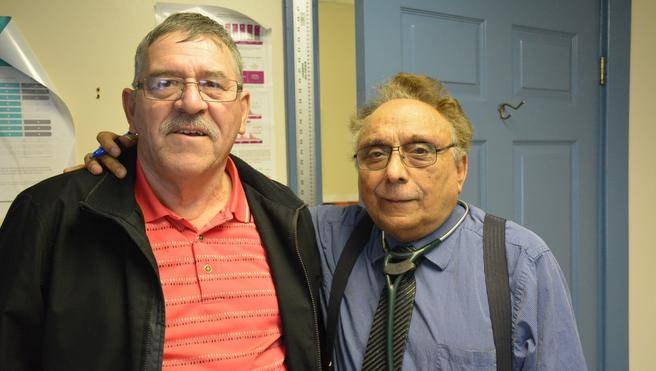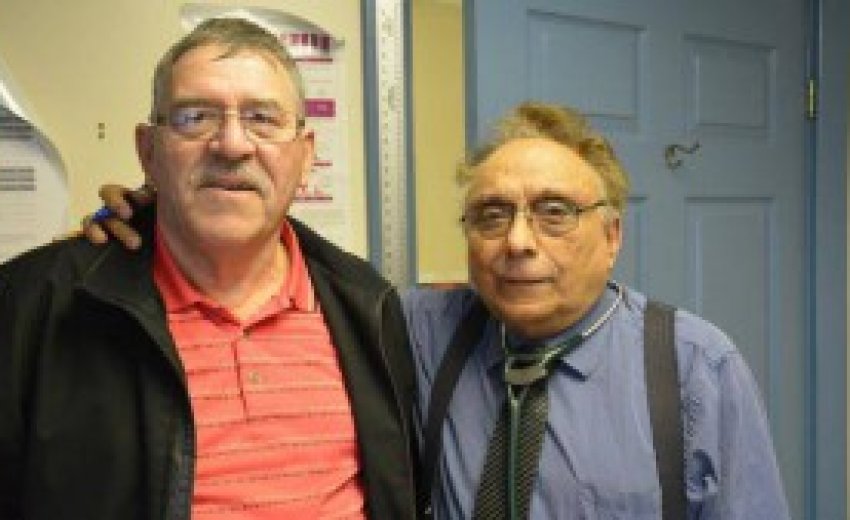Respected physician says First Nation needs the land ‘more than I do’
 |
| Michael Denny, left, a member of the Grand Council of Eskasoni First Nation, and Dr. Mohan Virick visit in Virick’s walk-in clinic in Sydney. (TOM AYERS / Cape Breton Bureau) |
April 23, 2014 : SYDNEY — A much-loved family doctor who spent more than 50 years treating patients at Eskasoni First Nation is giving back to the community by donating 140 hectares of land to the reserve. He’s also turning over to the band a commercial building and property in downtown Sydney.
Dr. Mohan Virick, originally from Burma, moved to Cape Breton in 1963 and began practising medicine in Sydney. His first patient was a Mi’kmaq man who helped him adjust to life in a new country and within a year he opened a new practice in Eskasoni.
A humble man, Virick said he delivered more than 4,000 babies in his career and he considers the First Nation, which currently has a population of about 4,000, his children.
“I worked there for over 50 years and delivered all the children there and they need more land,” said Virick, 78, who is semi-retired but still runs a walk-in clinic in Sydney three mornings a week. “They need it more than I do.”
Most of his walk-in patients are Mi’kmaq and during the course of an interview two patients came in to say hi. Their admiration for the man was obvious.
One of them, Michael Denny, a member of the Eskasoni Grand Council, said he has known Virick most of his life.
“He’s my great-grandfather,” said Denny. “Now my kids call him dad.”
Virick said he regularly gets calls, emails and visits from former patients who aren’t looking for treatment. They simply want to tell him how they’re doing.
“I’m just closing up my life and thought they could use it,” Virick said of the donations. “All my life I’ve been with (the people of Eskasoni). I owe them. It’s not something supernatural. When you live with them through good times and bad, you want to do something to help.”
Virick and his wife Mabel Ann, who hails from Glace Bay, have four children and nine grandchildren. Virick says he considers the residents of Eskasoni his fifth child.
“They are like my children. I love them like my kids. When you get older, you pass on things to your children. They are one of my children. I would have left it in my will, but I knew they need it now.”
The deed transfers are in the hands of lawyers, but a letter of intent has been signed and the transfers should go through shortly, Virick said.
The building at 440 George St. in Sydney does have some tenants and they are aware of the impending transfer of ownership, but they aren’t facing eviction, said Virick.
Eskasoni Chief Leroy Denny said Virick grew into the community and his generous gifts will be put to good use.
The band council hasn’t decided yet what it will do with the building in Sydney or the land, which is just west of the existing reserve and includes some water frontage.
However, the council holds an annual spring planning session and the donations will be a main topic.
Eskasoni is in good financial shape and it has a lot of land, said Denny, but the area is mountainous and not all of the reserve land is suitable for development.
Denny said the band will start the process of having Virick’s land converted to reserve status with an eye toward residential development, but no decisions have been made on that or the downtown property.
“It’s unusual and it’s a great gift,” he said. “Our community members are eternally grateful.”
Virick said he decided in elementary school that he wanted to move to Canada after seeing a National Film Board documentary on log rolling in British Columbia. He wrote to the Canadian embassy in Burma and they advised him to apply after he grew up.
After earning his medical licence at the Christian Medical College in India, he moved to Glace Bay and only had $5 in his pocket. An aboriginal man, Michael Sappier, helped Virick get into Sydney for his first day of work and that led to a close relationship.
Sappier became Virick’s first patient and he loaned Virick his suit so the doctor could get married. Sappier refused to take it back, saying he would like to be buried in it. Ten years later, Virick gave up the suit after Sappier died.
Despite that close relationship, Virick said it took him some time to really understand the Mi’kmaq culture.
“I wasted 10 years of my life,” he said. “I always looked down. But they were always teaching me and I learned it.”
Virick said he has no plans to fully retire and will keep on working at the walk-in clinic as long as he can.
“It’s just a life reasonably well lived,” he said.
[Dr. Virick is a senior member of the Maritime Sikh Socety, Halifax- JST]
